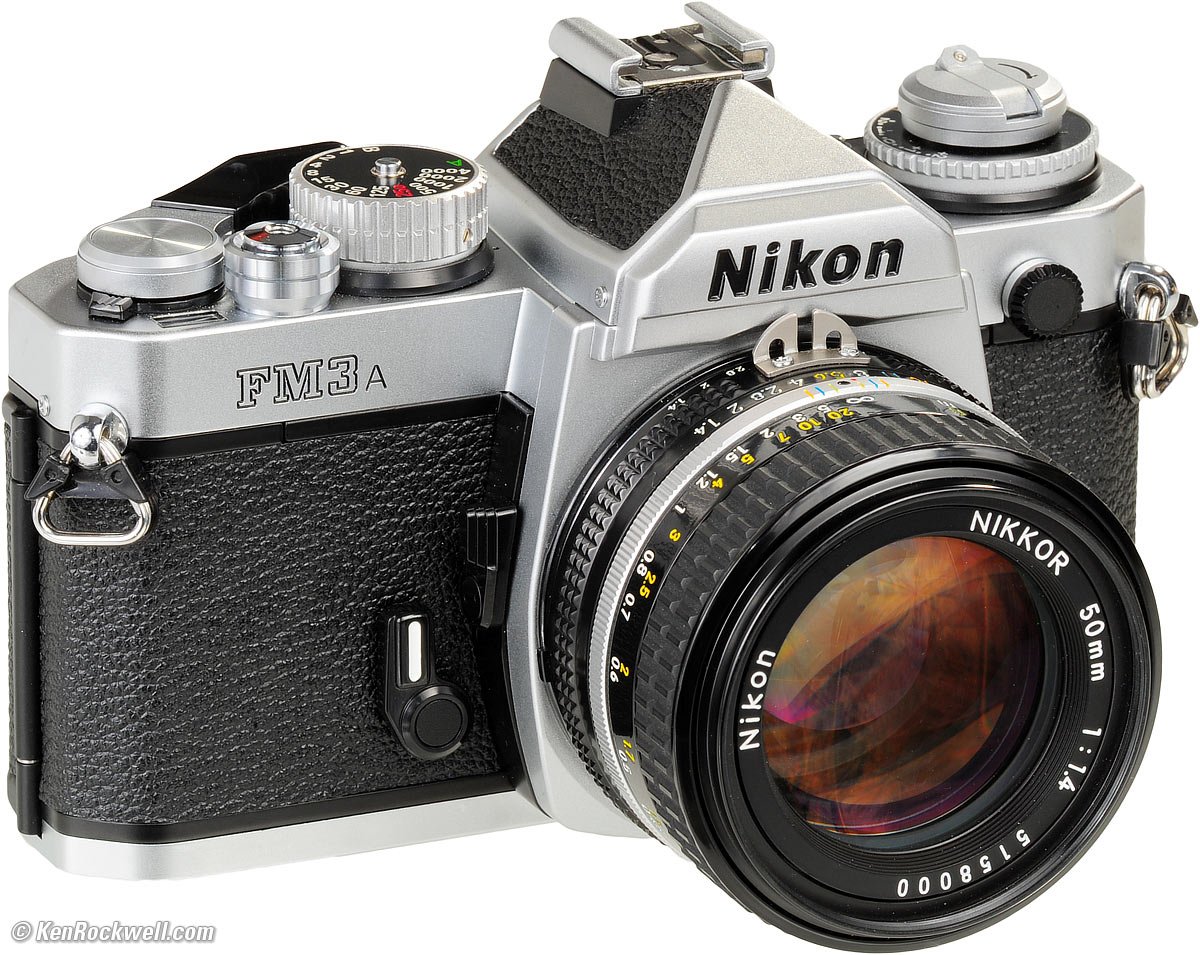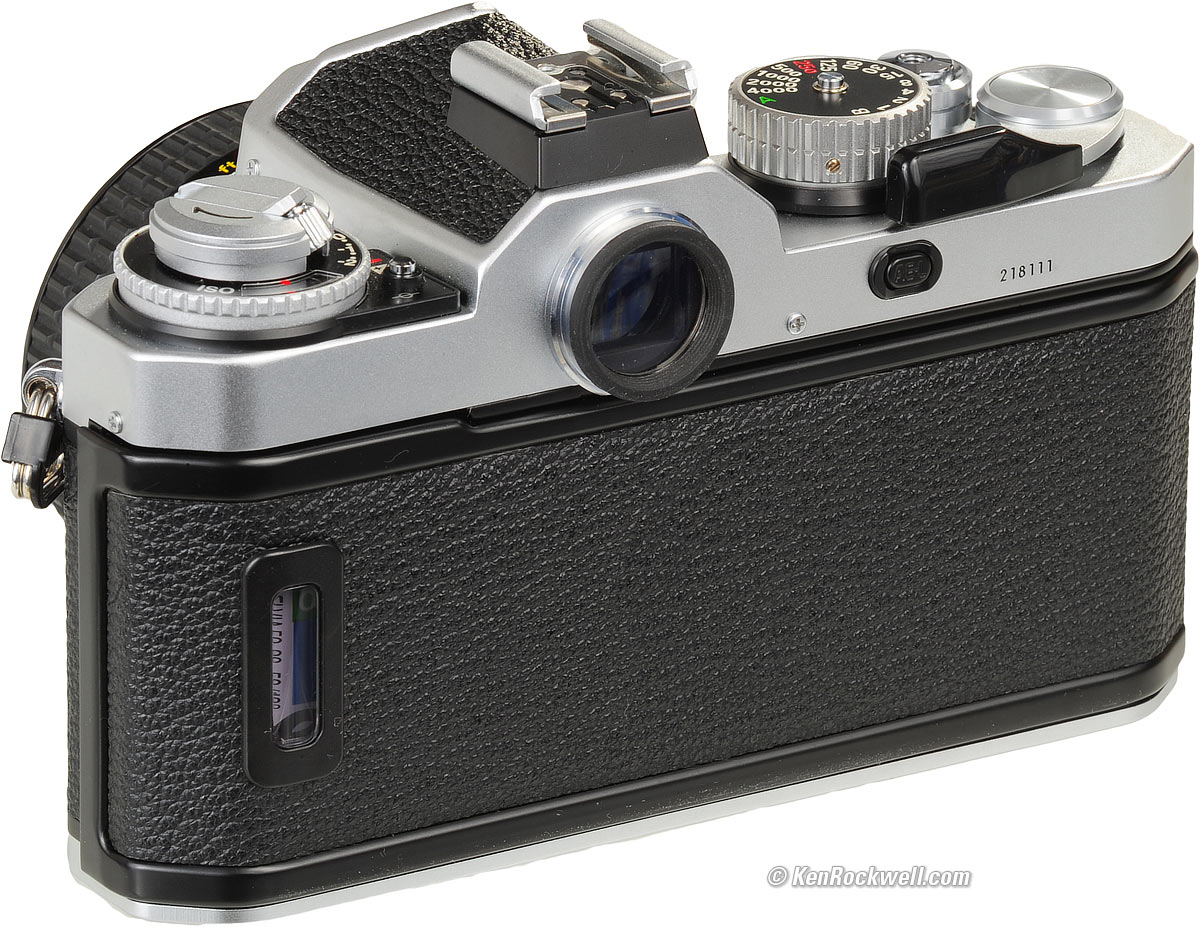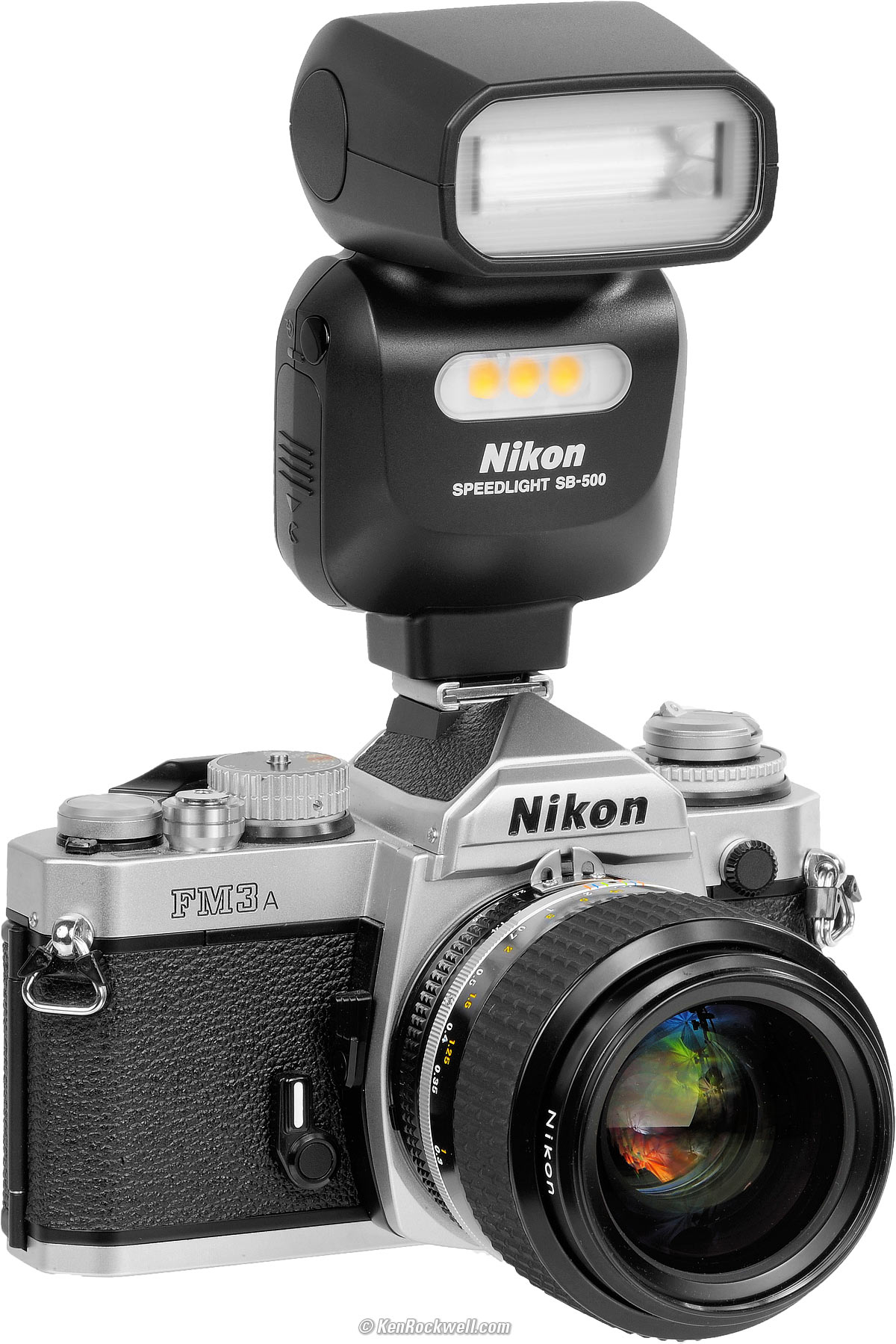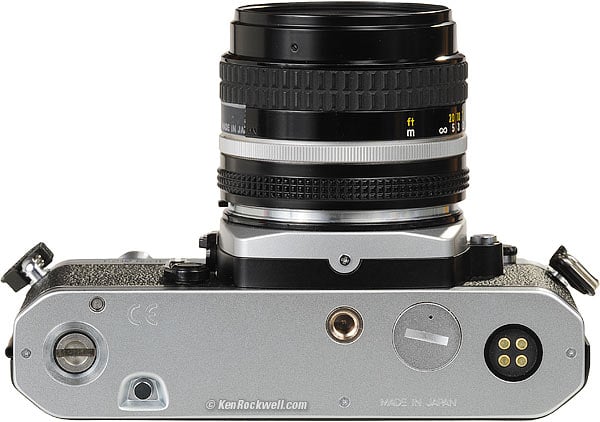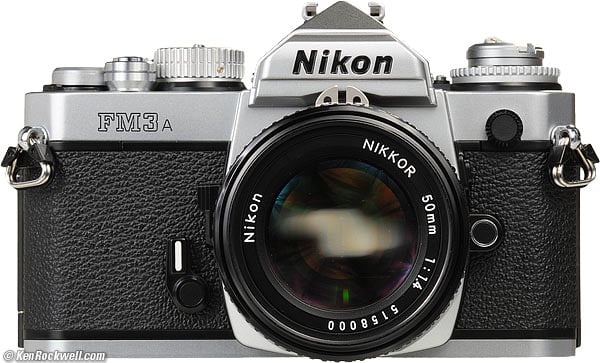Home Donate New Search Gallery How-To Books Links Workshops About Contact
Nikon FM3a
(2001-2006)
Intro Specs Performance Compared Usage Recommendations
Nikon FM3a with 50mm f/1.4 AI-s (20.905 oz./595.2g with film but without lens, about $900 used if you know How to Win at eBay). enlarge. I bought mine at this link to them at eBay and you can get acessories also from Adorama.
This free website's biggest source of support is when you use those or any of these links to approved sources when you get anything, regardless of the country in which you live — but I receive nothing for my efforts if you take the chance of buying elsewhere. I get no government hand-outs and run no pledge drives to support my research, so please always use any of these links to approved sources for the best prices, service and selection whenever you get anything. Thanks for helping me help you! Ken.
September 2022 Better Pictures Nikon Reviews Nikon Lenses Nikon Flash All Reviews
Nikon FE and FM Family Comparison Chart
Nikon FM3a (2001-2006)
Nikon FE2 (1983-1987)
Nikon FE (1978-1983)
Nikon EL2 (1977-1978)
Top, Nikon FM3a with 50mm f/1.4 AI-s. enlarge.
Back, Nikon FM3a with 50mm f/1.4 AI-s. enlarge.
Note the new film window, and the AE-Lock button on the back just under the film wind lever.
Introduction top
Intro Specs Performance Compared Usage Recommendations
|
|
The Nikon FM3a is one of the very best cameras ever made by Nikon, or anyone.
The Nikon FM3a incorporates every good feature of its forerunners, the FE, FE2, FM, FM2 and FM2n, and retains none of the bad. The FM3a is as if Nikon invited me to give them my wish list of everything I wanted included or deleted from every camera in this series over its 30-year history.
Unlike any other camera, the FM3a offers both the electronic automation of the FE and FE2, and also offers the complete, full-range mechanical, no-battery-required shutter of the FM, FM2 and FM2n!
The FM3a would just as rightly called an FE3, Maybe FE3+FM3 is more accurate; it does everything the FE and FM series did, all in one camera.
The Nikon FM3a is quite a feat of engineering, and hides this so well that it remains one of the easiest and fastest-handing Nikons of all time.
Unlike any other manual-focus Nikon, it adds a -1 stop TTL flash exposure compensation button for great fill flash.
This -1 stop TTL flash compensation means it's easy to shoot flash all day and night without ever taking your eye off your subject: hold the button for fill, and let it go for regular flash. Just be sure you're using a real NIKKOR manual-focus lens which can be focused with one finger, since your thumb will be used for the -1 stop TTL button.
The FM3a uses a proven analog needle to display metered shutter speeds in the finder. In manual mode, the meter is electronic, while the shutter remains mechanical. You easily can set set manual exposures by moving the shutter needle to match the meter needle, and it's trivial to see and set live exposure compensation, or use the zone system.
The FM3a goes beyond every other Nikon camera by having a uniquely advanced finder screen. Its split-image rangefinder is unique among all Nikons because it will not black-out with any lens, even if stopped down. This very clever split-image optical trick, used by Canon since the 1970s, lets the screen automatically adapt itself to the lens. It gives greater precision with fast lenses, and stays visible even with slower lenses.
The matte surface of the FM3a's standard K3 focus screen is optimized for lenses of f/2, allowing you to see actual depth-of field at f/2. This is quite different from the screens of AF and digital SLRs, whose screens are optimized for slower f/2.5 lenses. (If you use faster lenses, nothing gets brighter and you only see the defocus equivalent to that lens being stopped down to that aperture.)
The only thing the FM3a can't do are the extra features of the Nikon FA "Technocamera," which was 20 years ahead of its time. The FM3a has manual and aperture-priority auto exposure, but lacks the matrix metering or program or shutter-preferred automation of the FA.
The FM3a adds two more firsts for this camera series: a film-check window on the back, and DX automatic ASA setting.
The FM3a uses the same MD-12 motor drive as do all the other Nikon cameras this size.
The FM3a flew completely under my radar when it was introduced in July 2001.
Nikon marketed the FM3a as if it was some sort of men's jewelry, pitching it with the overpriced, underperforming 45mm f/2.8 AI-P lens, so many people ignored it.
This is too bad, because it turns out that the Nikon FM3a is Nikon's most intelligently designed and most ergonomically perfect camera of all time.
Unlike the FE2 and FA, you can expose frames 0 and 00 just as you can on the FE, for 39 perfect frames on every roll. The FE2 and FA turned off the meter and forced their shutters to 1/250 in frames 0 and 00 for the benefit of stupider photographers who thought their cameras were broken when they'd get stuck in 4-minute auto exposures with the lens cap on.
The FM3a is designed for the knowledgeable photographer, who today is the only one buying it. The Nikon FM3a is a total winner. it does everything my favorite FE does, but better. See my Nikon FE Review for a lot more about why these sorts of cameras are so great.
I got my FM3a used at eBay (How to Win at eBay).
Silver or Black? Introduction top
Like most great cameras, the FM3a comes in your choice of black or chrome.
The covers are drawn brass.
I predict that chrome will hold up longer, since it's all metal.
The black finish is enamel over brass, and enamel (paint) is softer than chrome (metal). Brass also shows more obviously under black, and is fairly invisible as chrome wears away.
FM3a with NIKKOR AI 35mm f/1.4s and SB-500 flash. bigger.
Compatibility Introduction top
I got my FM3a used at eBay (How to Win at eBay).
Lenses
The FM3a works great with every Nikon manual or autofocus lens made from 1959 through today, except:
1960s fisheyes that require mirror lockup won't mount. (The FM3a has an automatic mirror lockup in the self timer mode, but you can't lock it up continuously.)
Gelded (G) lenses only shoot at f/22 and require stop down metering
Original Nikon F (pre-AI or pre-1977) lenses require the AI upgrade.
Details at Nikon Lens Compatibility
Flash
Just about every flash works great, except the SB-400 and SB-900.
The SB-600 and SB-800 should work great. I tried my SB-600, and it works perfectly in TTL mode.
The older models (SB-15 - SB-80) also work great in their traditional TTL modes.
The SB-30 and SB-23 are compact and quite useful; I prefer the tiny SB-30 as a daylight TTL fill flash to carry everywhere.
Bottom, Nikon FM3a with 50mm f/1.4 AI-s. enlarge.
Specifications top
Intro Specs Performance Compared Usage Recommendations
I got my FM3a used at eBay (How to Win at eBay).
Finder
Glass pentaprism.
0.83x with 50mm lens.
93% coverage.
Central split-image, microprism collar, matte field.
Shutter
Auto
Electronic shutter, stepless analog control.
1/4,000 to at least three minutes (only specified to 8 seconds, but runs much longer).
Manual
Mechanical shutter.
1s - 1/4,000, sets in full stop clicks only.
The shutter dial does not rotate beyond B or A.
Remote Release
Standard cable release.
Weight
20.905 oz. (595.2g) ready to shoot with clear eyepiece cover, strap lugs, film and batteries, but no lens, strap or caps.
20.215 oz. (573.1g) same conditions, but without film.
Price (USA) Introduction top
2022 September: About $900 used if you know How to Win at eBay.
2019 April: About $800 used if you know How to Win at eBay.
2014 April: about $600 used if you know how to win at eBay.
2010 March: about $700 used.
2005 December: $580 chrome, $600 black, new, at NY city discount.
Performance top
Intro Specs Performance Compared Usage Recommendations
I got my FM3a used at eBay (How to Win at eBay).
Overall
The Nikon FM3a just goes. There's nothing that gets in your way.
Exposures, focus, batteries and everything work great.
Film Economy
39 perfect frames on a roll of 36.
I load with the first sprocket hole in the take-up spool at S, wind one frame and waste frame S+1, and start shooting at counter number 0 (S+2).
Finder
The finder is huge and bright.
The K3 focus screen is optimized for f/2 lenses. Faster lenses won't get any brighter.
Unique among all Nikons, the split-image never blacks out, regardless of how slow your lens.
Nikon FM3a with 50mm f/1.4 AI-s. enlarge.
For those of you with an optical bent, we're seeing the split image through the front of the lens. Every other Nikon, and most SLRs, show two offset rectangles, but in the case of this special split-image device, you see two fat blobs towards the center, which see through any slow lens, and the equivalent of two tabs getting pulled out to the edges of this f/1.4 lens, showing how the split image also sees with maximum precision with fast lenses.
Meter and Exposure
The exposure system is the best in the world.
There is no Matrix meter; you have to know the zone system, or at least enough to lock the meter to whatever you want as a medium tone.
I find the meter pattern, which concentrates on the big circle in the center of the finder, is my favorite. It's perfect for finding a medium area (or combination of light and dark).
The analog finder needle is my favorite display. It makes it easy to place highlights and shadows, and determine the exact correct exposure to use, instantly. When using LCDs, what's the correct exposure if highlight reads 350 and shadow reads 30? On the FM3a, it's obvious when the needle rests in the middle of the two, which just happens to be 1/108th of a second. Try doing that math in your head with digital displays.
A needle is also decades ahead of digital LEDs or LCDs because it's more precise (reads to a tenth of stop or better), reads instantly (not just once per second), and most critically, reads live over a 16-stop range or more. It will read two stops below B, and well above 1/4,000.
The FM3a's internal circuitry is all analog. Even though Nikon only rates its longest Auto exposure as 8 seconds, I had no problems making automatic exposures minutes long at ASA 100, and they come out correctly exposed.
Film Counter and Advance
The film advance lever return ratchet is a little smoother and quieter than the FE2 and FE.
Like the rest of the FM and FE series, you must push the wind lever all the way over to advance the film.
If you only draw it out halfway, it will return, and you won't complete advancing the film until you pull it all the way over on a second try.
20, 24 and 36 are in orange. It's quaint that 20 is in orange; film went from 20 to 24 exposures some time back in the 1970s.
The counter stops at 36.
Shutter Release
The trigger pull has a bit of a kink at the very end of the shutter button's travel. There is a bit of additional force required to overcome as the shutter fires. This is the same as the FE2, but worse than the FE. I prefer the smooth trigger pull of the FE; this notchy pull could lead to blurrier long hand-held exposures, but I had no problems.
Recoil is light, about the same or a little better than the FE and FE2, and much better than the FM.
Like the rest of the series, the shutter has a relatively sharp sound.
Power
Two A76, S76 or a single DL1/3N is all you need for the meter and auto exposure.
All the manual speeds are mechanical, and work great with no battery.
The meter and other circuits may be on while you're using the manual settings, and they will draw current, even if the shutter doesn't.
In Auto mode, the shutter is electronic and needs the battery.
Current Drain
Idle 0.1uA (about 200 years battery life).
Meter on: 3.5mA (low end of scale) to 3.8mA (1/4,000). (about 45 hrs battery life).
Shutter open, bulb: 73.5uA (about 2,000 hours battery life).
Shutter open, mechanical manual speeds 1s - 1/4,000: 3.2mA (meter stays on).
Shutter open in Auto: 13.8mA (about 11 hours battery life).
Rated Battery Life
Lithium |
2 x S76 |
2 x A76 |
|
| 68ºF (20ºC) | 110 rolls |
120 rolls |
50 rolls |
| (-10ºC) | 60 rolls |
65 rolls |
10 rolls |
Compared top
Intro Specs Performance Compared Usage Recommendations
I got my FM3a used at eBay (How to Win at eBay).
See my Nikon FE and FM Family Comparison Chart for more than you'd ever want to know.
Usage top
Intro Specs Performance Compared Usage Recommendations
I got my FM3a used at eBay (How to Win at eBay).
Batteries
Be careful inserting the batteries. I measured a 400mA drain if they were in backwards, which means they'd be dead in minutes.
Otherwise, no big deal. Use your choice of 2 x S76, 2 x A76, or one 3V Lithium.
Flash
When a Nikon flash is ready and you're set to AUTO, the shutter will only vary between about 1/60 and 1/250, or so it seems.
Nikon never says this in the manual because they figure we know these basics if we're buying an FM3a, or maybe they forgot.
Set to manual, you may set any speed you like. If you set 1/500 or faster, some of your frame will not be lit by flash.
To set slow sync, just set a manual speed as you look at the two needles in the finder. It's super-easy to do, without taking an eye from the finder. You can't do that with AF or digital cameras! If you want the background dimmer, just set a faster manual speed than read by the meter. Easy!
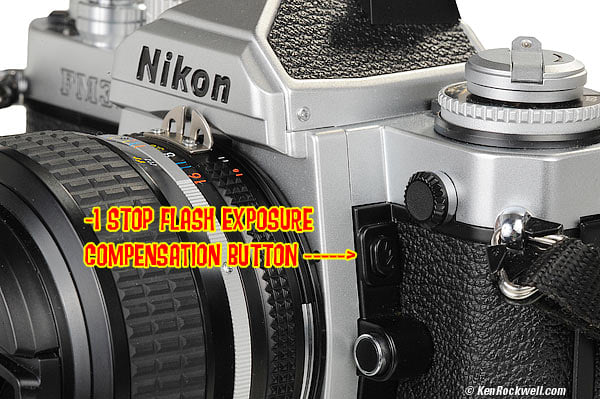
Nikon FM3a TTL flash exposure compensation button.
The -1 stop TTL Flash exposure compensation button is above the lens release button, on the side of the prism.
Press and hold the button to duck the flash by a stop. There is no finder indication.
Metering
The AEL button is on the back of the camera, just under the film advance lever.
Hold it to lock, during which you'll see the needle freeze.
Everything Else
See my Nikon FE Users Guide for all you need to know. What little is different you'll figure out easily.
Recommendations top
Intro Specs Performance Compared Usage Recommendations
I got my FM3a used at eBay (How to Win at eBay).
The FM3a is one of Nikon's best cameras ever, and because of that, it's still selling used for a little more than it sold for new.
If you want the newest and best, get an FM3a. You'll love it.
If money matters, the original Nikon FE is 99% the same camera for what most people, including myself, do, and the FE has a smoother shutter release than the this FM3a. For $35 I can buy a new FM3a K3 focus screen, which should pop right into the FE just as the K2 screens do.
I've never been a fan of the FE2 because it wastes two frames at the beginning of every roll. The FE and this FM3a don't.
I got my FM3a used at eBay (How to Win at eBay).
More Information
Nikon, Japan's write-up on the FM3a.
© Ken Rockwell. All rights reserved. Tous droits réservés. Alle Rechte vorbehalten.
Help Me Help You
I support my growing family through this website, as crazy as it might seem.
The biggest help is when you use any of these links when you get anything. It costs you nothing, and is this site's, and thus my family's, biggest source of support. These places always have the best prices and service, which is why I've used them since before this website existed. I recommend them all personally.
If you find this page as helpful as a book you might have had to buy or a workshop you may have had to take, feel free to help me continue helping everyone.
If you've gotten your gear through one of my links or helped otherwise, you're family. It's great people like you who allow me to keep adding to this site full-time. Thanks!
If you haven't helped yet, please do, and consider helping me with a gift of $5.00.
As this page is copyrighted and formally registered, it is unlawful to make copies, especially in the form of printouts for personal use. If you wish to make a printout for personal use, you are granted one-time permission only if you PayPal me $5.00 per printout or part thereof. Thank you!
Thanks for reading!
Ken Rockwell.
